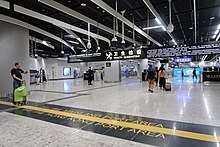
Hong Kong has a highly developed transport network, encompassing both public and private transport. Based on Hong Kong Government's Travel Characteristics Survey, over 90% of daily journeys are on public transport, the highest rate in the world. However, in 2014 the Transport Advisory Committee, which advises the Government on transportation issues, issued a report on the much-worsened congestion problem in Hong Kong and pointed at the excessive growth of private cars during the past 10–15 years.

The Mass Transit Railway (MTR) is a major public transport network serving Hong Kong. Operated by the MTR Corporation (MTRCL), it consists of heavy rail, light rail, and feeder bus services, centred around a 10-line rapid transit network, serving the urbanised areas of Hong Kong Island, Kowloon, and the New Territories. The system encompasses 245.3 km (152.4 mi) of railways, as of December 2022, with 179 stations—including 99 heavy rail stations, 68 light rail stops and 1 high-speed rail terminus.

The Kowloon–Canton Railway was a railway network in Hong Kong. It was owned and operated by the Kowloon–Canton Railway Corporation (KCRC) until 2007. Rapid transit services, a light rail system, feeder bus routes within Hong Kong, and intercity passenger and freight train services to China on the KCR network, have been operated by the MTR Corporation since 2007.

The West Rail line was a rapid transit line that formed part of the Mass Transit Railway (MTR) system in Hong Kong until 27 June 2021. Coloured magenta on the MTR map, the line ran from Tuen Mun to Hung Hom, with a total length of 35.7 kilometres (22.2 mi), in 37 minutes. The railway connected the urban area of Kowloon and the new towns of Yuen Long, Tin Shui Wai and Tuen Mun in the northwestern New Territories.
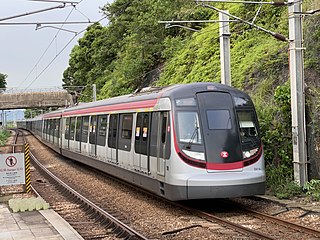
The East Rail line is one of the ten lines that form MTR, the mass transit system in Hong Kong. The railway line starts at Lo Wu or Lok Ma Chau, both of which are boundary crossing points into Shenzhen and joins in the north at Sheung Shui and ends at Admiralty station on Hong Kong Island. At approximately 46 km (29 mi), the line is the second longest line within the network, behind the Tuen Ma line. The line's colour is light blue, formerly navy blue before the KCR/MTR merger.

Lo Wu is the northern terminus of the East Rail line of Hong Kong, located in Lo Wu within the Closed Area on Hong Kong's northern frontier. The station serves as a primary checkpoint for rail passengers between Hong Kong and mainland China and vice versa, rather than serving a specific area. It is also the northernmost railway station in Hong Kong.

Hung Hom is a passenger railway station in Hung Hom, Kowloon, Hong Kong. It is an interchange station between the East Rail line and the Tuen Ma line domestic services of the MTR network, as well as the southern terminus of cross-border through-trains to mainland China which has been suspended since 4 February 2020. The station is one of four Hong Kong ports of entry on the MTR network; the others are Lo Wu, Lok Ma Chau, and West Kowloon. This station serves the southern terminus of the East Rail Line in early morning before the first northbound train from Admiralty arrives. As the station is located next to the Cross-Harbour Tunnel's northern portal, it is also served by many cross-harbour bus routes.
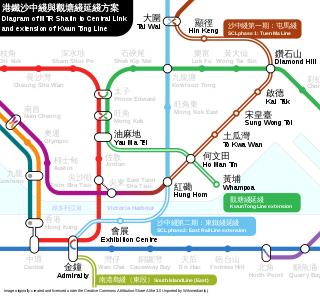
The Sha Tin to Central Link was an expansion project of the MTR public transport network in Hong Kong. It was divided into two sections and expanded the network’s heavy rail lines.

The Guangzhou–Kowloon through train was an inter-city railway service between Hong Kong and Guangzhou jointly operated by the MTR Corporation of Hong Kong and the Guangzhou Railway Group of mainland China. Services operate along the East Rail line within Hong Kong territory, crossing the Hong Kong–Chinese border at Lo Wu, and continuing along the Guangmao Railway and Guangshen Railway in Guangdong province.

The Beijing–Kowloon through train was an intercity railway service between Hung Hom station in Hong Kong and the Beijing West railway station in China, jointly operated by the MTRC of Hong Kong and China Railway, China's national rail service. The train ran to Beijing and Hong Kong every other day. Services used the East Rail line in Hong Kong, crossed the boundary between Hong Kong and mainland China at Lo Wu and then continued along China's railway network via the Guangshen railway and the Jingguang railway to Beijing. Total journey time was approximately 23 hours, and the train uses 25T class train carriages.
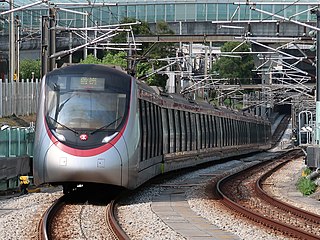
The Tuen Ma line is a rapid transit line that forms part of the Mass Transit Railway (MTR) system in Hong Kong. Coloured brown on the map, the Tuen Ma line is 56.2 kilometres (34.9 mi) in length, making it the longest line of the MTR network. It has a total of 27 stations, more than any other in the MTR system.

The Hong Kong section of the Guangzhou–Shenzhen–Hong Kong Express Rail Link is a 26 km (16 mi) long stretch of high-speed rail that runs along a dedicated underground rail corridor linking Hong Kong to mainland China. It is one of the most expensive infrastructure undertakings in Hong Kong's history. The line connects Kowloon with the high-speed rail network of China at Futian station in the technology hub of Shenzhen, then running north towards the commercial/ political hub of Guangzhou. As of August 2023 the line has an average ridership of 79,000 passengers a day.

The Guangzhou–Shenzhen–Hong Kong Express Rail Link (XRL), also known as the Guangshengang XRL, is a high-speed railway line that connects Guangzhou and Hong Kong (Kowloon) via Shenzhen. Officially, the line is the Guangzhou–Shenzhen–Hong Kong section of the Beijing–Guangzhou–Shenzhen–Hong Kong high-speed railway.

The Beijing–Guangzhou–Shenzhen–Hong Kong high-speed railway or Jingguangshengang high-speed railway from its Chinese name is a high-speed railway corridor of the CRH passenger service, connecting Beijingxi station in Beijing and Futian station in Shenzhen, Guangdong in less than nine hours of travel time. It is 2,230 kilometres (1,390 mi) long, and is the only Chinese high-speed railway to cross a border that requires immigration and customs clearance. The existing, conventional Jingguang railway runs largely parallel to the line.

Hong Kong's rail network mainly comprises public transport trains operated by the MTR Corporation Limited (MTRC). The MTRC operates the metro network of the territory, the commuter rail network connecting the northeastern, northwestern and southwestern New Territories to the urban areas, and a light rail network in northwestern New Territories. The operations of the territory's two leading railway companies, MTRC and the Kowloon-Canton Railway Corporation (KCRC), were merged in 2007 on grounds of economies of scale and cost effectiveness. The Hong Kong Government has an explicit stated transport policy of using railways as its transport backbone.

Futian station is a station on the Guangzhou–Shenzhen–Hong Kong Express Rail Link, and the final station in mainland China before trains enter Hong Kong. Futian District is in southern Shenzhen, where the central business district is located. The station opened on 28 June 2011 serving the Shenzhen Metro, and since 30 December 2015 it has been the first underground high speed railway station on a long-distance line in China. It serves as an interchange station between the Guangzhou–Shenzhen–Hong Kong Express Rail Link and Line 2, Line 3 and Line 11 of the Shenzhen Metro.

Vibrant Express, also known as MTR CRH380A or MTR380A is a high-speed train operated by Hong Kong government-owned public transport operator MTR. It was manufactured by Chinese state-owned manufacturer CSR Qingdao Sifang based on the CRH380A Hexie EMUs developed for China Railway. Nine 8-car trainsets were ordered by the Hong Kong government through the MTR Corporation and delivered between 2016-17. It is the first high-speed train produced by CRRC not operated by China Railway.

The Beijing–Hong Kong high-speed train is a high-speed train service operated by China Railway Guangzhou Group on Beijing–Guangzhou–Shenzhen–Hong Kong HSR in China. Operated with G79/80 train numbers between Beijing West and Hong Kong West Kowloon on a daily basis, it is currently the fastest train service and the only high-speed train service between Beijing and Hong Kong, with an approximate travelling time of 8.5 hours.
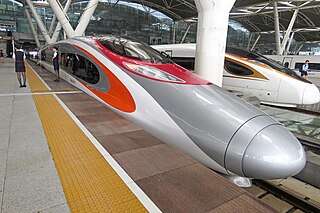
The Guangzhou–Hong Kong high-speed train are high-speed train services operating between Guangzhou South in Guangzhou and Hong Kong West Kowloon in Hong Kong.

The Shenzhen–Hong Kong high-speed train are high-speed train services operating between Shenzhen and Hong Kong.















